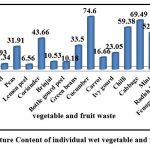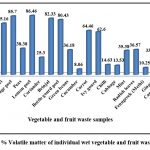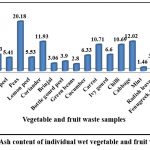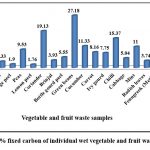Manuscript accepted on : 27-04-2023
Published online on: 20-06-2023
Plagiarism Check: Yes
Reviewed by: Dr. Manobendro Sarker
Second Review by: Dr. Nishant Kumar
Final Approval by: Dr. Hifzur R. Siddique
Proximate Analysis of Vegetable and Fruit Waste Collected from the Kadi Vegetable Market, Gujarat
Pooja J. Gupta* , Minal J. Trivedi
, Minal J. Trivedi and Harsha P. Soni3
and Harsha P. Soni3
Department of Biotechnology, Pramukh Swami Science and H.D. Patel Arts College, SV Campus, Kadi, Gujarat, India.
Corresponding Author E-mail: guptapooja0096@gmail.com
DOI : http://dx.doi.org/10.13005/bbra/3121
ABSTRACT: Vegetable and fruit waste are produced in huge quantities in the market. These wastes are also nutritionally very rich and, can be a viable option to be used as a substrate for the generation of value-added products. However, there is a need to characterize these wastes before using them as raw materials for the production of any value-added product. In this regard, the present study was taken up to determine the proximate analysis of vegetable and fruit waste. Proximate analysis is a way to determine the distribution of moisture, ash, volatile matter, and fixed carbon when the samples are heated under specified conditions. The discarded vegetable and fruit waste was collected from Kadi municipal vegetable market. The proximate analysis was carried out for 23 waste samples viz, 20 samples were a wet waste of individual fruits and vegetables and 3 samples were of consolidated sundried vegetable and fruit waste. Presented Proximate analysis of vegetable and fruit waste includes the determination of moisture, ash, volatile matter, and fixed carbon via standard test methods. The result revealed that for wet waste moisture content was in the range from 6.56 % to 77.57 %. Percentage of volatile matter was in the range from 8.06% to 86.46 %. Percentage Ash content was in the range from 1.32 % to 20.18 %.Percentage Fixed carbon was in the range from 1.76 % to 28.63 %. The moisture content in sundried consolidated waste was in the range from 5.83 % to 8.86 %. The percentage of the volatile matter was in the range from 62.06 % to 72.33 %. Percentage Ash content was in the range from 11.16 % to 12.83 %. Percentage Fixed carbon was in the range from 8.79 % to 16.27 %.
KEYWORDS: proximate analysis; Percentage moisture content; Percentage volatile matter; Percentage ash content; and Percentage fixed carbon; Vegetable market waste
Download this article as:| Copy the following to cite this article: Gupta P. J, Trivedi M. J, Soni H. P. Proximate Analysis of Vegetable and Fruit Waste Collected from the Kadi Vegetable Market, Gujarat. Biosci Biotech Res Asia 2023;20(2). |
| Copy the following to cite this URL: Gupta P. J, Trivedi M. J, Soni H. P. Proximate Analysis of Vegetable and Fruit Waste Collected from the Kadi Vegetable Market, Gujarat. Biosci Biotech Res Asia 2023;20(2). Available from: https://bit.ly/3NCLYU5 |
Introduction
India’s diverse climate ensures the availability of all varieties of fresh vegetables and fruits. India is the second-largest producer of fruits, as well as vegetables, in the world 1,2. Globally, the production of fruits and vegetables is about 675 million metric tons annually and out of which 1.3 billion tons of waste is produced 3. As reported by Food and Agriculture Organization (FAO) India alone produces 103.03 million metric tons of fruits and 197.23 million tons of vegetables annually. But this constitutes about 40 to 50 % of waste annually 2. Most of this waste is dumped in an open place without any treatment which causes hazardous diseases and environmental issues. So, proper waste management is necessary 4.
According to the survey, Kadi municipal vegetable market generates approximately more than one thousand kg of vegetable waste per day. These huge amounts of waste are dumped on land to rot in the open air and create a nuisance in municipal landfills. Additionally, these wastes are nutritionally very rich and are important sources of dietary fibers, vitamins, minerals compounds, and phytochemicals 5. So, for waste management, we need to devise some essential techniques for recycling and converting these nutritionally rich waste into value-added products like compost, liquid biofertilizer, Enzymes, Organic acid, bioactive compounds, Bio-pigments and colorants, Bio-degradable plastic, Biofuel 6.
Composting is one of the major recycling processes by which nutrients present in organic materials are returned back to the soil. The application of organic manure or compost to soil provides benefits including improving the fertility, structure, and water-holding capacity of the soil 7. In the composting process, organic waste are the main source of nutrients 8. These organic waste such as vegetable and fruit waste possesses all the characteristics essential for efficient composting 9. Furthermore, the quality and stability of compost are entirely dependent on the waste properties of raw materials 8. Therefore, vegetable and fruit waste need to be characterized to understand their nature for application as raw materials 10.
In 11 Germany invented the method for quantitative analysis of different micronutrients in food called proximate analysis. This is important in evaluating the combustion properties of waste.
The fractions of interest are first, the percentage of moisture content, which adds weight to the waste without increasing its heating value, and the evaporation of water, which reduces the heat released from the waste. The second is volatile matter, that portion of the waste is converted to gases before and during combustion, Third is the percentage of inorganic waste material (ash) which represents the mineral of wastes and the fourth one is the solid-state (fixed carbon) which represents the carbon remaining on the surface of waste 12.
Moisture content is an important parameter in composting process. Microbial activity, oxygen consumption rate, temperature, and porosity level are all affected by moisture levels during composting. For an effective composting process 50-60% (v/w) moisture levels are essential 13. The moisture content is used as a measure of stability and susceptibility to microbial contamination. Additionally, the high moisture content can be responsible for the rapid deterioration of this waste if unprocessed for long after harvesting 13. Volatile matter (VM) refers to volatile components of raw vegetable and fruit waste, excluding moisture, which is liberated at higher temperatures in absence of air 14. The volatile matter is generally used to describe the biodegradable nature of the organic fraction of vegetable and fruit waste. Higher volatile matter indicates the higher biodegradability of the raw material 14.
Ash is the inorganic residue remaining after the water and organic matter have been removed by heating in the presence of oxidizing agents. Ash content represents the total mineral content in waste. The ash content of compost is likely to increase with increased degradation of the organic matter 15.
The novelty of this works since not many research articles showed to characterize of proximate components of wet individual waste and sundried waste before being used as raw materials in composting process. So, the present study involves a collection of vegetable and fruit waste samples from the Kadi municipal vegetable market located in District Mehsana, Gujarat, and analyzing these wastes. Two kinds of waste were used for proximate analysis 1) Individual waste and 2) Mix consolidated waste. Individual wet waste was used directly for analysis. The mixed consolidated waste was characterized after drying by exposure to sunlight. In the future aspect, proposed to use this wet waste along with dried waste as raw material in composting process for waste management and increasing soil fertility.
Materials and Methods
Sample collection
Diverse vegetable and fruit waste samples were collected from the Kadi vegetable market and transferred to the laboratory for analysis. The samples consist of 20 kinds of wet vegetable and fruit waste samples like potato, onion, beet, orange peel, peas, coriander, brinjal, bottle gourd peel, green beans, cucumber, carrot, ivy gourd, chili, cabbage, mint, radish leaves, fenugreek, ginger, cauliflower, tomato. For consolidated waste 3 samples were collected randomly from the common dumping area. The consolidated waste samples were sun-dried before analysis.
Sample preparation
The samples of wet individual vegetable and fruit waste were thoroughly washed with tap water. The samples were shredded and homogenized with a cutter 16. Proximate analysis was carried out to determine the contents of percentage moisture, volatile matter, ash, and fixed carbon according to the standard method 17. Analysis was determined by putting 2 gm of each sample in different ranges of temperature between 110 °C and 950 °C.
Proximate analysis
Determination of Moisture content
The 2 gm of each sample was taken in a crucible. The sample containing the crucible was placed in a hot air oven at 105 ± 2 ˚C till constant weight was obtained. The crucible was cooled in a desiccator and finally, the weight of the sample was taken to determine the loss in weight due to the removal of moisture 18,19.
The moisture content of the sample was calculated as below equation
% Moisture content = 100 (Loss in weight after drying) /Total weight of sample taken
Determination of volatile matter
The dried sample of the vegetable and fruit waste was left in the crucible and then covered with a lid. It was placed in an electric furnace (muffle furnace) maintained at 900 ± 10°C. Then crucible was taken out of the furnace after 7 min of heating. The crucible was first exposed to air before being placed in a desiccator and weighed again. Loss in weight was reported as a volatile matter on a percentage basis. The percentage of the volatile matter was calculated as the following equation 18,19.
% Volatile matter = 100 (Loss in weight after heating) /Total weight of sample taken – % Moisture content
Determination of ash content
The total ash content of a sample was the percentage of inorganic residue remaining after the volatile matter has been burnt. Samples were placed in a crucible and burnt in a muffle furnace at 500°C for 30 min in an uncovered crucible. It was cooled in a desiccator and weighed at room temperature to get the weight of the ash. The percentage ash content was calculated as the following equation 18,19.
%Ash content = 100 (Weight of ash obtained after heating)/ Total weight of sample taken
Determination of fixed Carbon
The fixed carbon was calculated by subtracting the sum of moisture, ash, and volatile matter from 100 percent and was calculated using the below equation 18,19.
% Fixed carbon = 100 – (% Moisture + % Volatile matter + % Ash)
Statistical analysis
All the experiments were carried out in triplicates. The Mean values and standard deviations of each waste were calculated using Microsoft excel. The result was tabulated as mean ± standard deviation 20.
Results and Discussion
Table 1: Proximate analysis of dry consolidated vegetable market waste. (Change format)
|
Sr. no |
Sample name |
Composition of mixed waste |
% Moisture Mean± SD |
%Volatile matter Mean± SD |
% Ash Mean± SD |
% Fixed Carbon Mean± SD |
|
1 |
Sample 1 |
Radish, cabbage leaves, Brinjal, Tomato, Orange, Mint, Coriander, Cauliflower, Snake gourd, Apple |
8.86±0.05 |
62.06±0.36 |
12.83±0.15 |
16.27±0.01 |
|
2 |
Sample 2 |
5.83±0.05 |
66.78±0.11 |
11.16±0.11 |
16.25±0.02 |
|
|
3 |
Sample 3 |
6.55±0.005 |
72.33±0.15 |
12.4±0.1 |
8.79±0.10 |
SD: Mean ± standard deviation
Determination of Moisture content
 |
Figure 1: % Moisture Content of individual wet vegetable and fruit waste samples
|
Figure 1: show the percentage moisture content of 20 selected wet vegetable and fruit waste samples.The moisture percentage of vegetable and fruit waste was in the range from 6.56±0.05% to 77.57±0.29 %. The highest moisture content was found in fenugreek (Methi) followed by cucumber and the least moisture content was found in lemon peel (6.56±0.05%). According to 19 Pathak et al., 2016 reported 6.10% of the moisture content presented in lemon peel. Out of 20 samples, 9 samples have moisture content above 40%, 5 samples have moisture content above 20% and 6 samples have very low moisture content. The ideal moisture content for composting was reported to be between 50 to 60 % 13. So, individual waste may not be suitable for composting but mixing different waste in appropriate combinations can be feasible to obtain ideal moisture content for composting. Previous studies by 21 Bishnoi et al., 2020 showed a moisture content of 80.89 % in fenugreek. 4 Kamau et al., 2020 reported that moisture content in cabbage (94.87±2.56%), Coriander (92.12±4.47%), and Cucumber (95.86±2.04%). It was slightly high as compared to our sample of Cabbage (69.49±0.11%), Coriander (43.66±0.41%), and Cucumber (74.6±0.41%) because the sample was affected by many environmental factors (during harvesting, post-harvest handling, transportation, storage marketing, and physical changes in it 22.
Table 1: depicts the percentage moisture content of dry consolidated waste samples. The moisture content for dry consolidated waste ranged from 6.55±0.005% to 8.86±0.05%. The present study clearly shows that leafy and fresh vegetable waste has higher moisture content than dry consolidated waste, so these dry consolidated samples can be used as raw material to maintain the moisture level in the composting process.
Determination of volatile matter
 |
Figure 2: % Volatile matter of individual wet vegetable and fruit waste samples
|
Figure 2 shows the percentage of volatile matter present in wet individual vegetable and fruit waste samples. The percentage of the volatile matter was in the range of 8.06±0.15% to 86.46±0.46%. The highest percentage of volatile matter found in lemon peel was (86.46±0.46%) followed by orange peel (85.7±0.56%) and the least percentage of the volatile matter was found in cucumber (8.06±0.15%). 19 Pathak et al., 2016 reported that 87.16 % of volatile matter present in lemon peel, and 23 Uzuazokaro et al., 2018 reported that 0.94 ± 0.24 % of volatile matter present in cucumber.
Table 1 shows the percentage of volatile matter present in the dry consolidated waste. The volatile matter of dry consolidated waste was in the range from 62.06±0.36% ± to 72.33±0.15%.
Determination of ash content
 |
Figure 3: % Ash content of individual wet vegetable and fruit waste samples
|
Figure 3 depicts the percentage of ash content present in vegetable and fruit waste. The ash content in leafy vegetables was higher compared to other vegetable and fruit waste samples. The % Ash content varied in the range from 1.32±0.07% to 20.18±0.29%. The Highest Ash content was recorded in peas peel (20.18±0.29 %) and the least ash content was recorded in Fenugreek (Methi) (1.32±0.07%). 24 Naqvi et al., 2021 reported that 4.47±0.51 % Ash content in pea peel. % Ash content in our pea peel waste was higher as compared to the reported ash content present in peas peel.
Table 1 shows the % ash content in dry consolidated waste. In dry consolidated waste percentage ash content varied in the range from 11.16±0.11 % to 12.83±0.15%.The percentage ash content of wet leaf vegetable waste and dry consolidated waste was found to be similar. The ash content represents the minerals present in the waste. It has been shown that the mineral content of the waste is unaffected by drying.
Determination of fixed carbon
 |
Figure 4: % fixed carbon of individual wet vegetable and fruit waste samples
|
Figure 4 depicts the percentage of fixed carbon present in vegetable and fruit waste. The percentage fixed carbon of wet vegetable and fruit waste samples was in the range from 1.76±0.1% to 28.63±0.60%. The highest percentage fixed carbon was recorded in potatoes (28.63±0.60 %) and the least % fixed carbon was recorded in lemon peel (1.76±0.11 %). Previous studies by 19 Pathak et al., 2016 reported 1.34% percentage of fixed carbon in lemon peel.
Table: 1 show the percentage of fixed carbon present in the dry consolidated waste. The fixed carbon of dry consolidated waste was in the range form 8.79±0.10% to 16.27±0.01%.
Conclusion
The present study aims to characterize the proximate components of various vegetable and fruit waste samples obtained from the Kadi municipal vegetable market which is located in the Gujarat district of Mehsana. Total 23 samples were used for the analysis. Out of 20 wet samples studied, for 9 sample show moisture levels optimum for composting process. Dried consolidated waste samples have lower moisture content. For the composting process, 50 to 60% moisture level is needed. Proposed to form a mixture of dried waste along with wet samples and then proceed for composting. Higher volatile matter indicates the higher biodegradability nature of vegetable and fruit waste. Some wet individual waste has low volatile matter as compared to dried consolidated waste. An interesting relationship was observed between the moisture content and volatile matter content. The moisture content correlated inversely with volatile matter i.e when the moisture content was high the volatile matter was found to be low in all the waste samples. The ash content represents the minerals present in the waste. In the present work ash content of wet leafy vegetables, waste was found to be similar to dried consolidated waste samples. It can be indicated that the mineral content of the waste is unaffected after drying of the waste samples. Concerning to the fixed carbon content in all samples tested, no major difference was found among wet individual waste samples and dried consolidated waste samples.
Acknowledgment
We are thankful to the Gujarat State Biotechnology Mission, and the Government of Gujarat for providing funds for the research work as a Major Research Project grant. We are also thankful to Pramukh Swami Science and H.D. Patel Arts College, Kadi for all the facilities and support.
Conflict of Interest
The authors would hereby like to declare that there is no conflict of interests that could possibly arise.
Funding sources
We are thankful to the Gujarat State Biotechnology Mission (GSBTM) providing funds for the research work.
References
- Singh Dak. Problems and prospects of fruits and vegetables marketing in india. Int J Multidiscip Educ Res. 2020;9(Sep):162–78. Available from: https://www.researchgate.net/publication/345901276% 0ATeacher
- Gupta P, Trivedi M, Soni H. Screening for diverse biopolymer degrading microbes from vegetable market waste of kadi. Life Sci Leaflet. 2020;4297:21–30. Available from: https://petsd.org/ojs/ index.php/lifesciencesleaflets/article/view/1545
- Omre P., Singh S, . S. Waste utilization of fruits and vegetables . South Asian J Food Technol Environ. 2018;04(01):605–15. Available from: https://doi.org/10.46370/sajfte.2018.v04i01.02
CrossRef - Kamau J. M., Mbui D. N. MJ and MFB. Proximate analysis of fruits and vegetables wastes from Nairobi County, Kenya. Res J Food Sci Nutr. 2020;5:2536–7080. Available from: https://doi.org/10.31248/RJFSN2019.088
CrossRef - Septembre-Malaterre A, Remize F, Poucheret P. Fruits and vegetables, as a source of nutritional compounds and phytochemicals: Changes in bioactive compounds during lactic fermentation. Food Res Int. 2018;104:86–99. Available from: https://doi.org/10.1016/j.foodres.2017.09.031
CrossRef - Singh R, Das R, Sangwan S, Rohatgi B, Khanam R, Peera SKPG, et al. Utilisation of agro-industrial waste for sustainable green production: a review. Environ Sustain. 2021;4(4):619–36. Available from: https://doi.org/10.1007/s42398-021-00200-x
CrossRef - Sayara T, Basheer-Salimia R, Hawamde F, Sánchez A. Recycling of organic wastes through composting: Process performance and compost application in agriculture. Agronomy. 2020;10(11):1–23.
CrossRef - Pan I, Dam B. Composting of common organic wastes using microbial inoculants. Biotech 2:127–134. 2012;127–34. Available from: https://doi.org/10.1007/s13205-011-0033-5
CrossRef - Willson GB. Organic waste processing. Biocycle. 1989; Available from: https://doczz.net/doc/7366206/
- Singh A, Kuila A, Adak S, Bishai M, Banerjee R. Utilization of Vegetable Wastes for Bioenergy Generation. Agric Res. 2012;1(3):213–22. Available from: https://doi.org/10.1007/s40003-012-0030-x
CrossRef - Henneberg, W. and Stohman F. Begründung einer rationellen Ftterung der Wiederkäuer. Vol. 1. Schwetschtke u. Sohn, Braunschweig, Germany. 1860. Available from: https://www.worldcat.org/ title/ beitrage-zur-begrundung-einer-rationellen-futterung-der-wiederkauer/oclc/637913562
- Elmaz F, Yucel Ö, Mutlu, Yener A. Machine Learning Based Approach for Predicting of Higher Heating Values of Solid Fuels Using Proximity and Ultimate Analysis. Int J Adv Eng Pure Sci. 2020;32(2):145–51. Available from: https://doi.org/10.7240/jeps.558378
CrossRef - Rastogi M, Nandal M, Khosla B. Heliyon Microbes as vital additives for solid waste composting. Heliyon. 2020;6:1–11. Available from: https://doi.org/10.1016/j.heliyon.2020.e03343
CrossRef - Singh A, Mukhopadhyay D, Sarkar JP, Dutta S. Studies on effect of plastic on biodegradation of vegetable solid market waste through detailed analysis of leachate. J Solid Waste Technol Manag. 2014;40(3):266–84. Available from: https://www.researchgate.net/publication/276835740%250
CrossRef - Park YW. Determination of moisture and ash content of foods. Thesis. 1996. Available from: https://www.researchgate.net/publication/282135010
- Asquer C, Pistis A, Scano EA. Characterization of fruit and vegetable waste as a single substrate for the anaerobic digestion. Evironmental Eng Manag. 2013;12(11):89–92. Available from: http://omicron.ch.tuiasi.ro/EEMJ/
- ASTM. Standard Test Method for Gross Calorific Value of Refuse-Derived Fuel by the Bomb Calorimeter. ASTM Standard. 2004. 711–87 p.
- Gebreslassie MG, Gebreyesus HB, Gebretsadik MT, Bahta ST, Birkie SE. Characterization of Municipal Solid waste’s Potential for Power Generation at Mekelle City as a Waste Minimisation strategy. Int J Sustain Eng. 2020;13(1):68–75. Available from: https://doi.org/10.1080/19397038.2019.1645757
CrossRef - Pathak PD, Mandavgane SA, Kulkarni BD. Characterizing fruit and vegetable peels as bioadsorbents. Curr Sci. 2016;110(11):2114–23. Available from: https://doi.org/10.18520/cs/v110/i11/2114-2123
CrossRef - Chatepa L, Masamba, Kingsley and Jose M. Proximate composition , physical characteristics and mineral content of fruit , pulp and seeds of Parinari curatellifolia ( Maula ) from Central Malawi. African J Food Sci. 2018;12(9) pp.:238–45. Available from: https://www.researchgate.net/ publication/328580496
CrossRef - Bishnoi S, Chhikara N, Singhania N, Ray AB. Effect of cabinet drying on nutritional quality and drying kinetics of fenugreek leaves (Trigonella foenum-graecum L.). J Agric Food Res. 2020;2:100072. Available from: https://doi.org/10.1016/j.jafr.2020.100072
CrossRef - Pathak PD, Mandavgane SA, Kulkarni BD. Fruit peel waste: Characterization and its potential uses. Curr Sci. 2017;113(3):444–54. Available from: https://doi.org/10.18520/cs/v113/i03/444-454
CrossRef - Uzuazokaro M-MA, Okwesili FCN, Chioma AA. Phytochemical and proximate composition of cucumber (Cucumis sativus) fruit from Nsukka, Nigeria. African J Biotechnol. 2018;17(38):1215–9. Available from: https://www.researchgate.net/publication/328533254
CrossRef - Naqvi SAZ, Irfan A, Zaheer S, Sultan A, Shajahan S, Rubab SL, et al. Proximate composition of orange peel, pea peel and rice husk wastes and their potential use as antimicrobial agents and antioxidants. Vegetos. 2021;34(2):470–6. Available from: https://doi.org/10.1007/s42535-021-00213-1
CrossRef

This work is licensed under a Creative Commons Attribution 4.0 International License.





